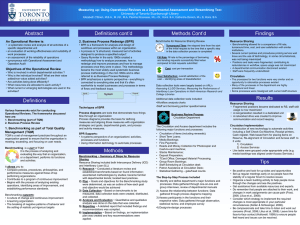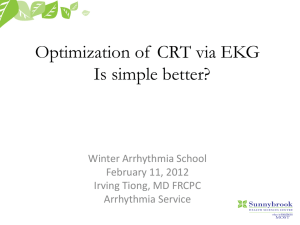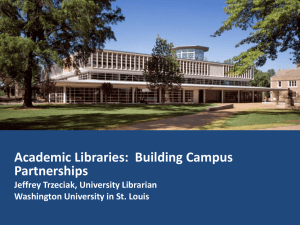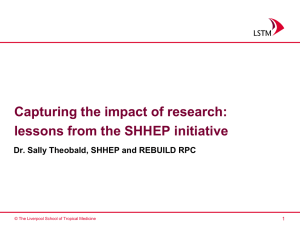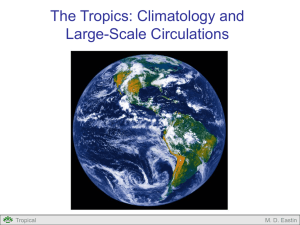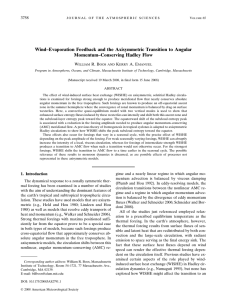Monash_M19_141105
advertisement
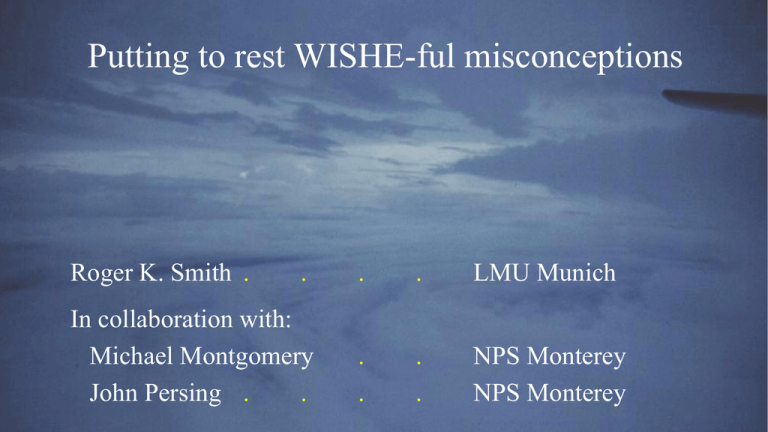
Putting to rest WISHE-ful misconceptions Roger K. Smith . . . . LMU Munich In collaboration with: Michael Montgomery John Persing . . . . . . NPS Monterey NPS Monterey Topic of talk: tropical cyclone intensification 1. How do tropical cyclones intensify? • Important physical principles • The basic thought experiment for intensification 2. Paradigms for intensification 3. The most widely accepted explanation for intensification in textbooks, didactic material and the peer-reviewed literature is the WISHE mechanism. 3. What and how is it supposed to work? 4. Current “explanations” of WISHE 5. Test of WISHE using idealized model simulations with simple physics 6. Conclusions Tropical cyclone intensification Basic principle: conservation of absolute angular momentum: M rv 1 2 M r M v v M r 1 2 fr If r decreases, v increases! Spin up requires radial convergence fr 2 The basic thought experiment for intensification Initial condition Mean sounding Axisymmetric vortex V(r,z) p(z) T(z) q(z) r 26oC sea Nguyen, Smith and Montgomery, QJRMS, 2008: Idealized numerical model simulations, simple physics, MM5 5 km horizontal grid spacing, 24 s-levels The primary circulation Pressure gradient force 1 ¶p r ¶r LO r v sea Sum of Centrifugal force and Coriolis force V2 + fV r Frictionally-induced secondary circulation Pressure gradient force secondary circulation r v v Centrifugal force and Coriolis force are reduced by friction The four most prominent paradigms for tropical cyclone intensification 1. The CISK paradigm (Charney and Eliassen 1964; Ooyama 1964; Carrier 1971) 2. The cooperative intensification paradigm (Ooyama 1969, 1982; Willougby 1990, 1995) 3. A thermodynamic air-sea interaction instability paradigm (aka WISHE) for intensification (Rotunno and Emanuel 1987; Emanuel 1989; Emanuel et al. 1994; Emanuel 1997, 2003; Holton 2004); and 4. A new rotating convective paradigm (Nguyen et al. 2008; Montgomery et al. 2009, Smith et al. 2009, Bui et al. 2009, Fang and Zhang 2011, Persing et al. 2013). First three paradigms are axisymmetric, the fourth presents a three-dimensional view that includes an azimuthally-averaged (system-scale) view. Review by Montgomery and Smith, AMOJ (2014), in press. The secondary, or in-up-out, circulation secondary circulation secondary circulation C A ds V Conventional view of intensification: axisymmetric Thermally-forced secondary circulation leads to spin up 15 z km 10 v M r 1 fr 2 5 M materially conserved 0 50 r km 100 M not materially conserved, inflow feeds the clouds with moisture Revised view : two coupled spin-up mechanisms 15 z km 10 v M r 1 fr 2 5 M materially conserved 0 50 r km 100 M reduced by friction, but strong convergence small r large v REPLACE Available at: http://met.nps.edu/~mtmontgo/papers/M8_95.pdf 2013 Specific analysis focusing on the intensification phase, including the RI phase of the simulated TC, reveals the following points. The WISHE mechanism seems to play a role in RI (phase 2) of the simulated TC. … Emanuel’s 1997 model for hurricane intensification z M M(e) e = e(p) Tout ( e ) M , e * Boundary layer controls de/dM M rv h Time-dependent slab model for boundary layer thermodynamics re rmax r 1 2 fr 2 The Wind Induced Surface Heat Exchange Paradigm: WISHE An air-sea interaction instability paradigm for intensification Comprises a multi-step feedback loop involving, in part, the near-surface wind speed and the evaporation of water from the underlying ocean, the evaporation rate being a function of wind speed and thermodynamic disequilibrium. Until very recently, the WISHE mechanism has been presented as a finiteamplitude instability that requires a finite-amplitude precursor disturbance generated by some independent means (such as an easterly wave) to “kick start the heat engine” (cf. Hakim 2011; Holton and Hakim 2012). More on WISHE The WISHE mechanism has been presented as a finite amplitude instability of an incipient tropical depression vortex and has achieved widespread acceptance in: Meteorology textbooks and other didactic material (e.g., Rauber et al. 2008; Holton 2004; Ahrens 2008; The COMET Program 2013) Tropical weather briefings, and The current literature (Lighthill 1998; Smith 2003; Molinari et al. 2004; Nong and Emanuel 2004; Montgomery et al. 2006; Terwey and Montgomery 2008; Braun et al. 2010; Fang and Zhang 2010). Indeed, the last five citations and others have talked about “igniting the WISHE mechanism” after the vortex (or secondary maximum in the tangential wind) has reached some threshold intensity. How does WISHE work? The mechanism is a multi-step feedback loop of the axisymmetric flow and requires in part that the sea-to-air moisture fluxes increase with wind speed. r r r sfc e p int V int Thermal wind balance qv e start 2 V m ax rm (TB T0 ) sfc qv sfc r c pd ln e B Ltop * qv qv 0 * Fq C E | V | (q v q v ) Vsfc - Vm ax BLtop v In the standard WISHE paradigm, the vortex will NOT intensify WITHOUT the windspeed dependence of the moisture fluxes. AMS Glossary 2013 Quotes A hypothesis for the amplification of certain atmospheric circulations, including tropical cyclones, polar lows, and the Madden-Julian oscillation. The mechanism involves a positive feedback between the circulation and heat fluxes from the sea surface, with stronger circulation giving rise to larger surface fluxes of heat, which are then quickly redistributed aloft by convection, in turn strengthening the circulation. In this theory, emphasis is placed on the surface fluxes as the principal ratelimiting process; convection serves only to redistribute heat. This can be contrasted with conditional instability of the second kind (CISK), in which circulations amplify through their interaction with the convection itself. AMS Glossary 2013: problems 1. Ambiguity about which circulation is pertinent to the feedback process and what circulation is being amplified (i.e., the primary (swirling) or secondary (overturning) circulation, or the juxtaposition of both?). 2. The connection between the redistribution of heat aloft and the strengthening of the primary circulation is not clearly explained. 3. What physical mechanism(s) are envisaged to strengthen the circulation(s)? 4. The explanation fails also to mention whether the feedback process requires a finite-amplitude initiating disturbance as originally presented (Emanuel 1989, 1991). 5. The explanation implies that the intensification rate is limited by the surface heat fluxes so that if the heat fluxes are greatly reduced from their nominal values the intensification rate should be greatly reduced also. Quotes Wikipedia 2013 WISHE is a positive feedback mechanism between the ocean and atmosphere in which a stronger ocean-to-atmosphere heat flux results in a stronger atmospheric circulation, which results in a strong heat flux. It has been hypothesized that this is the mechanism by which low pressure areas in the tropics develop into tropical cyclones. Some issues Unclear what circulation is pertinent to the feedback mechanism, what circulation is being amplified, and what type of heat transfer is involved (i.e., sensible, latent or radiative heat transfer?). How does the “stronger ocean-to-atmosphere heat flux” lead to a stronger atmospheric circulation? No explicit mention is given to the wind-speed dependent nature of the heat flux. Quotes Rauber et al. 2008, Severe and Hazardous Weather Tropical cyclone intensification occurs as sensible and latent heat and moisture are extracted from the ocean surface by the action of the wind, and carried into the core of the tropical depression. Subsidence in the center of the cloud cluster leads to adiabatic warming and the lowering of surface pressure, intensifying the surface winds, and significantly increasing the rate of transfer of heat from the ocean to the atmosphere. The heat is transferred upward to the tropopause with the developing eyewall. Issue Adiabatic warming on account of subsidence in the central region of the cloud cluster is envisaged to create the warming of the upper troposphere, which is then linked hydrostatically to the surface pressure drop and the presumed increase in maximum tangential wind speed, and so on. The increase in the rate of heat transfer with increasing winds is noted. Fang and Zhang 2010 Quote The way in which mesoscale deep convection is organized to form a larger-scale TC vortex. ... In the framework of WISHE, winds associated with a surface vortex enhance fluxes of sensible and latent heat from the ocean surface, and vigorous convection transports the energy from the ocean surface to the upper troposphere and then fuels the intensification of the vortex. Some issues Do not say how the transport of energy from the ocean surface to the upper troposphere “fuels the intensification of the vortex”? How does the vortex actually intensify by upward energy transport? Kepert 2011 Review article Quote The role of the surface enthalpy fluxes in making the expansion of the inflowing boundary layer air isothermal rather than adiabatic ... . Some issues Kepert appears to associate the elevation of boundary-layer e with just the sensible heating. Kepert does not mention the necessity of the wind-speed dependence of the surface heat fluxes and does not make a distinction between dry and moist enthalpy in his discussion. The COMET Program: Introduction to Tropical Meteorology, 2013 Quotes An alternative view of a tropical cyclone is to consider it to be a closed system, a “Carnot engine”, rather than the moist, frictionally driven convective “chimney” of CISK. A Carnot engine is a closed system in which heat energy is converted to mechanical energy. As with the CISK theory, this WISHE tropical cyclone intensity theory relies on the presence of a finite amplitude incipient disturbance Issues Here, WISHE is used as a theory for tropical cyclone potential intensity, and neither the wind-speed dependence of the fluxes of latent and sensible heat, nor the putative wind-evaporative feedback mechanism that supports the intensification of the vortex are mentioned. The COMET Program: Introduction to Tropical Meteorology, 2013 Quote from “Links between Inner Core Dynamics, Cyclone Structure and Intensity” The key to a storm maintaining its current intensity or intensifying further is the maintenance of the deep convection surrounding its core. Maintenance of intensification by the WISHE process requires a very moist boundary layer. Subsaturated convective downdrafts will lower the relative humidity (and thus, the moist static energy) of the boundary layer, limiting the energy available to the storm. It will take a number of hours for evaporation to recover the boundary layer moisture before intensification can resume. Issues Here, the evaporation of surface water is mentioned explicitly, but not the windspeed dependence of the evaporation rate and the multi-step process that comprises the putative intensification mechanism. It is not explained how moist the boundary layer must become for the WISHE intensification process to be maintained or resume. Quotes Holton 2004 According to the WISHE view, the potential energy for hurricanes arises from the thermodynamic disequilibrium between the atmosphere and the ocean. The efficacy of air-sea interaction in providing potential energy to balance frictional dissipation depends on the rate of transfer of latent heat from the ocean to the atmosphere. This is a function of surface wind speed; strong surface winds, which produce a rough sea surface, can increase the evaporation rate greatly. Thus, hurricane development depends on the presence of a finite-amplitude initiating disturbance, such as an equatorial wave, to provide the winds required to produce strong evaporation. Given a suitable initial disturbance, a feedback may occur in which an increase in inward spiraling surface winds increases the rate of moisture transfer from the ocean, which by bringing the boundary layer toward saturation increases the intensity of the convection, which further increases the secondary circulation. Issues Holton 2004 The description of the feedback process is presented in the system-scale context, presumably for the azimuthally-averaged component of the flow, and explicitly notes the wind-speed dependence of the moisture fluxes as well as the importance of bringing the boundary layer toward saturation. The description notes also the necessity of an initiating disturbance of possibly independent origin. However, it is unclear what specific metric is meant by “increases the intensity of convection” and by what process(es) the increase in convective intensity results in an increase in the secondary circulation. The increase of the secondary circulation presumably leads to an increase of the primary circulation by angular momentum considerations, but the description is silent about this. A stringent test on the necessity of WISHE Initial condition Convectively Neutral Sounding Axisymmetric vortex T(z) q(z) V(r,z) r p 27oC sea CAPPED V = 10 m/s in heat fluxes for r < 300 km 300 km ZERO HEAT FLUX for r > 300 km Journal of Advances in Modelling Earth Systems, Nov. 2014 (minor revision) Available at: http://met.nps.edu/~mtmontgo/publications Is WISHE essential? Uncapped Cap 10 m s-1 Cap 5 m s-1 Conclusions To further test previous work, new idealized three-dimensional numerical experiments have been conducted using a state-of-the-art cloud model (CM1) with and without capped wind speed in the latent and sensible heat fluxes at near trade wind values (10 m s-1 & 5 m s-1). Based on these experiments, we conclude that the implied linkage between nearsurface wind speed and surface enthalpy fluxes during rapid intensification in the recent work of Miyamoto and Takemi (2013, JAS) is merely a coincidence. Our results affirm prior work showing that the putative multi-step WISHE feedback mechanism is not an essential pathway of tropical cyclone intensification in the prototype configuration that has been used to underpin the paradigm. We recommended that the WISHE acronym and related hypothetical descriptions of tropical cyclone intensification be retired and that current textbook descriptions be revised accordingly to reflect recent advances in tropical cyclone intensification theory and observations. Thank you for your attention!
